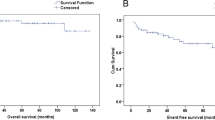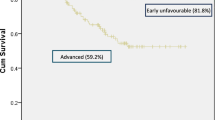Abstract
Limited information is available from developing countries on long-term outcome of patients with Hodgkin’s lymphoma (HL). Between January 1998 and December 2005, 262 patients (age ≥15 years) underwent treatment. Patients’ median age was 30 years, ranging from 15 to 72 years. Male to female ratio was 2.8:1. B symptoms were present in 64% of patients. Seventy percent of patients had stage III and IV disease. Mixed cellularity (52.3%) was the most common histology followed by nodular sclerosis (38%). ABVD chemotherapy was used in 85% of the patients, and 50% received radiotherapy as consolidation. Following treatment 92% of patients achieved complete response. Five-year freedom from treatment failure (FFTF) and overall survival rate are 78.3% and 86.6% ± 0.02% (95% CI 80.0–93.2%), respectively. Stage at presentation, number of lymph node regions involved (≥3 vs ≤2), presence of B symptoms, and serum albumin (≥40 vs <40 g/L) were important determinants of FFTF. In a subset analysis of stage I and II HL patients, presence of bulky disease and pure infradiaphragmatic disease was associated with inferior outcome. On multivariate analysis involvement of three or more number of lymph node regions was a significant predictor of inferior freedom from treatment failure survival (hazard ratio 2.2, p < 0.01). Our analysis confirms excellent outcome for patients of Hodgkin’s lymphoma with results comparable to developed countries.



Similar content being viewed by others
References
Bonadonna G (2000) Historical review of Hodgkin’s disease. Br J Haematol 110:504–511
Diehl V, Thomas RK, Daniel R (2004) Hodgkin’s lymphoma—diagnosis and treatment (part II). Lancet Oncol 5(1):19–26
Armitage JO (2010) Early-stage Hodgkin’s lymphoma. NEJM 363:653–662
Kuruvilla J, Keating A, Crump M (2011) How I treat relapsed and refractory Hodgkin lymphoma? Blood 117(16):4208–4217
Shanta V, Sastri DV, Sagar TG, Sasikala K, Krishnamurthi S (1982) A review of Hodgkin’s disease at the Cancer Institute, Madras. Clin Oncol 8(1):5–15
Dinshaw K, Pande S, Advani SH, Ramakrishnan G et al (1985) Pediatric Hodgkin’s disease in India. J Clin Oncol 3:1605–1612
Chandi L, Kumar L, Kochupillai V, Dawar R, Singh R (1998) Hodgkin’s disease: a retrospective analysis of 15 years experience at a large referral center. Natl Med J India 11:212–217
Arya LS, Dinand V, Thavaraj V, Bakhshi S, Dawar R, Rath GK, Singh R, Vats TS (2006) Hodgkin’s disease in Indian children: outcome with chemotherapy alone. Pediatr Blood Cancer 46:26–34
Raina V, Sharma A, Mohanti BK, Kumar R, Dawar R, Rath GK (2003) Etoposide, vinblastine, adriamycin and prednisolone (EVAP) combination chemotherapy as first-line treatment for Hodgkin’s disease. Natl Med J India 16:199–203
Laskar S, Gupta T, Vimal S et al (2004) Consolidation radiation after complete remission in Hodgkin’s disease following six cycles of doxorubicin, bleomycin, vinblastine, and dacarbazine chemotherapy: is there a need? J Clin Oncol 22:62–68
Lister TA, Crowther D, Sutcliffe SB et al (1989) Report of a committee convened to discuss the evaluation and staging of patients with Hodgkin’s disease: Cotswolds meeting. J Clin Oncol 7:1630–1636
Jaffe ES, Harris NL, Stein H, Vardiman JW (eds) (2001) World Health Organization classification of tumors. Pathology and genetics of tumors of hematopoietic and lymphoid tissues. IARC Press, Lyon
Kumar L, Malik PS, Prakash G, Prabu R, Radhakrishnan V, Kayal S, Hariprasad R (2011) Autologous hematopoietic stem cell transplantation—what determines the outcome: an experience from North India. Ann Hematol. doi:10.1007/s00277-011-1205-4
Miller AB, Hoogstraten B, Staquet M, Winkler A (1981) Reporting the results of cancer treatment. Cancer 47:207–211
Hasenclever D, Diehl V (1998) A prognostic score for advanced Hodgkin’s disease. International Prognostic Factors Project on Advanced Hodgkin’s Disease. N Engl J Med 339:1506–1514
Mauch PM, Kalish LA, Kadin M, Coleman CN, Osteen R, Hellman S (1993) Patterns of presentation of Hodgkin disease. Implications for etiology and pathogenesis. Cancer 71(6):2062–2071
Horner MJ, Ries LAG, Krapcho M, Neyman N, Aminou R, Howlader N, et al. (2009) SEER Cancer Statistics Review, 1975–2006, National Cancer Institute. Bethesda, MD. http://seer.cancer.gov/csr/1975_2006/. Based on November 2008 SEER data submission, posted to the SEER web site, 2009. Accessed 21 Mar 2010
Vassallo J, Paes RP, Soares FA et al (2005) Histological classification of 1,025 cases of Hodgkin’s lymphoma from the State of São Paulo, Brazil. São Paulo Med J 123:134–136
Cheong JW, Park SY, Roh JK, Suh CO, Hahn JS (2006) Treatment of Hodgkin’s disease: a twenty-year follow-up of patients at a center in Korea. Yonsei Med J 47:455–465
Dinand V, Dawar R, Arya LS, Unni RS, Mohanty B, Singh R (2007) Hodgkin’s lymphoma in Indian children: prevalence and significance of Epstein–Barr virus detection in Hodgkin’s and Reed–Sternberg cells. Eur J Cancer 43:161–168
Karnik BS, Nair S (2003) Hodgkin’s lymphoma: immunohistochemical features and its association with EBV LMP-1. Experience from a South Indian hospital. Pathology 35:207–211
Glaser SL, Hsu JL (2002) Hodgkin’s disease in Asians: incidence patterns and risk factors in population-based data. Leuk Res 26:261–269
Allemani C, Sant M, De Angelis R, Marcos-Gragera R, Coebergh JW (2006) EUROCARE Working Group. Hodgkin disease survival in Europe and the U.S.: prognostic significance of morphologic groups. Cancer 107:352–360
Brenner H, Gondos A, Pulte D (2009) Survival expectations of patients diagnosed with Hodgkin’s lymphoma in 2006–2010. Oncologist 14:806–813
Brenner H, Gondos A, Pulte D (2008) Ongoing improvement in long-term survival of patients with Hodgkin disease at all ages and recent catch-up of older patients. Blood 111:2977–2983
Verdecchia A, Francisci S, Brenner H et al (2007) EUROCARE-4 Working Group. Recent cancer survival in Europe: a 2000–02 period analysis of EUROCARE-4 data. Lancet Oncol 8:784–796
Eichenauer DA, Bredenfeld H, Haverkamp H, Müller H, Franklin J, Fuchs M et al (2009) Hodgkin’s lymphoma in adolescents treated with adult protocols: a report from the German Hodgkin Study Group. J Clin Oncol 27:6079–6085
Specht L, Nissen NI (1988) Hodgkin’s disease stages I and II with infradiaphragmatic presentation: a rare and prognostically unfavourable combination. Eur J Haematol 40(5):396–402
Darabi K, Sieber M, Chaitowitz M, Braitman LE, Tester W, Diehl V et al (2005) Infradiaphragmatic versus supradiaphragmatic Hodgkin lymphoma: a retrospective review of 1,114 patients. Leuk Lymphoma 46(12):1715–1720
Gerhartz HH, Beykirch M, Hitter E, Wilmanns W (1993) Chemotherapy dose and survival in advanced Hodgkin’s disease. Acta Haematol 89:137–140
Evens AM, Cilley J, Ortiz T et al (2007) G-CSF is not necessary to maintain over 99% dose-intensity with ABVD in the treatment of Hodgkin lymphoma: low toxicity and excellent outcomes in a 10-year analysis. Br J Haematol 137(6):545–552
Boleti E, Mead GM (2007) ABVD for Hodgkin’s lymphoma: full-dose chemotherapy without dose reductions or growth factors. Ann Oncol 18(2):376–380
Author information
Authors and Affiliations
Corresponding author
Rights and permissions
About this article
Cite this article
Ganesan, P., Kumar, L., Raina, V. et al. Hodgkin’s lymphoma—long-term outcome: an experience from a tertiary care cancer center in North India. Ann Hematol 90, 1153–1160 (2011). https://doi.org/10.1007/s00277-011-1262-8
Received:
Accepted:
Published:
Issue Date:
DOI: https://doi.org/10.1007/s00277-011-1262-8




